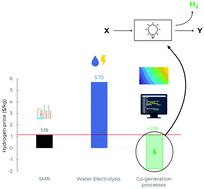当前位置:
X-MOL 学术
›
Energy Environ. Sci.
›
论文详情
Our official English website, www.x-mol.net, welcomes your
feedback! (Note: you will need to create a separate account there.)
Economically advantageous pathways for reducing greenhouse gas emissions from industrial hydrogen under common, current economic conditions
Energy & Environmental Science ( IF 32.4 ) Pub Date : 2021-2-15 , DOI: 10.1039/d0ee03768k Cody E. Finke 1, 2, 3, 4, 5 , Hugo F. Leandri 2, 3, 4, 5, 6 , Evody Tshijik Karumb 2, 3, 4, 5, 6 , David Zheng 4, 7, 8, 9 , Michael R. Hoffmann 4, 7, 8, 9, 10 , Neil A. Fromer 4, 8, 9, 10
Energy & Environmental Science ( IF 32.4 ) Pub Date : 2021-2-15 , DOI: 10.1039/d0ee03768k Cody E. Finke 1, 2, 3, 4, 5 , Hugo F. Leandri 2, 3, 4, 5, 6 , Evody Tshijik Karumb 2, 3, 4, 5, 6 , David Zheng 4, 7, 8, 9 , Michael R. Hoffmann 4, 7, 8, 9, 10 , Neil A. Fromer 4, 8, 9, 10
Affiliation

|
Hydrogen is a major industrial chemical whose manufacture is responsible for ∼3% of global carbon dioxide emissions. >95% of hydrogen is made via reforming fossil fuels which typically co-produces hydrogen and waste carbon dioxide. Nearly all other hydrogen is co-produced with other commodity chemicals. Unfortunately, many alternative, clean hydrogen production processes are small-scale because they require major reductions in capital cost or energy prices to be economical enough for industry. Because the climate problem is urgent, and the economics of future energy is uncertain, this paper seeks to expand the options for producing industrial-scale, clean hydrogen under common, present-day economic conditions. First, we build a model to understand the economic and carbon dioxide emissions constraints of sulfur electrolysis which is an emerging process that cogenerates hydrogen and co-salable sulfuric acid and has the potential to produce up to 36% of the world's current hydrogen demand under present-day, average US economic conditions. We also use our model to evaluate water electrolysis, which cogenerates hydrogen and waste oxygen, but is not economical under present-day average US economic conditions. We then propose criteria for identifying clean hydrogen production chemistries. Using these criteria, we find enough reactions to have the combined potential to make over 150% of the world's industrial hydrogen needs under present-day, average US economic conditions while reducing cost and reducing or eliminating CO2 emissions. Given the urgency of the climate problem, we believe that an economic analysis, such as this is crucial to near-term CO2 emissions reductions.
中文翻译:

在常见的当前经济条件下减少工业氢温室气体排放的经济上有利的途径
氢气是一种主要的工业化学品,其制造量约占全球二氧化碳排放量的3%。超过95%的氢是通过改造通常共同生产氢气和废二氧化碳的化石燃料。几乎所有其他氢与其他日用化学品共同生产。不幸的是,许多替代性的清洁氢气生产工艺规模很小,因为它们需要大幅度降低资本成本或能源价格,才能使工业经济。由于气候问题迫在眉睫,并且未来能源的经济状况不确定,因此本文试图扩大在当今常见的经济条件下生产工业规模的清洁氢气的选择。首先,我们建立一个模型来了解硫电解的经济和二氧化碳排放限制,硫电解是一种新兴的过程,可以同时产生氢气和可出售的硫酸,并有可能生产世界上36%的硫酸。在当今美国平均经济状况下当前的氢气需求。我们还使用我们的模型来评估水电解过程,水电解过程会同时产生氢和废氧,但在目前的美国平均经济条件下并不经济。然后,我们提出了用于鉴定清洁氢气生产化学物质的标准。使用这些标准,我们发现有足够的反应可以组合起来,在当今美国平均经济条件下,满足全球150%以上的工业用氢需求,同时降低成本并减少或消除二氧化碳 然后,我们提出了用于鉴定清洁氢气生产化学物质的标准。使用这些标准,我们发现有足够的反应可以组合起来,在当今美国平均经济条件下,满足全球150%以上的工业用氢需求,同时降低成本并减少或消除二氧化碳 然后,我们提出了用于鉴定清洁氢气生产化学物质的标准。使用这些标准,我们发现有足够的反应可以组合起来,在当今美国平均经济条件下,满足全球150%以上的工业用氢需求,同时降低成本并减少或消除二氧化碳2排放。鉴于气候问题的紧迫性,我们认为进行这样的经济分析对于短期内减少CO 2排放至关重要。
更新日期:2021-02-15
中文翻译:

在常见的当前经济条件下减少工业氢温室气体排放的经济上有利的途径
氢气是一种主要的工业化学品,其制造量约占全球二氧化碳排放量的3%。超过95%的氢是通过改造通常共同生产氢气和废二氧化碳的化石燃料。几乎所有其他氢与其他日用化学品共同生产。不幸的是,许多替代性的清洁氢气生产工艺规模很小,因为它们需要大幅度降低资本成本或能源价格,才能使工业经济。由于气候问题迫在眉睫,并且未来能源的经济状况不确定,因此本文试图扩大在当今常见的经济条件下生产工业规模的清洁氢气的选择。首先,我们建立一个模型来了解硫电解的经济和二氧化碳排放限制,硫电解是一种新兴的过程,可以同时产生氢气和可出售的硫酸,并有可能生产世界上36%的硫酸。在当今美国平均经济状况下当前的氢气需求。我们还使用我们的模型来评估水电解过程,水电解过程会同时产生氢和废氧,但在目前的美国平均经济条件下并不经济。然后,我们提出了用于鉴定清洁氢气生产化学物质的标准。使用这些标准,我们发现有足够的反应可以组合起来,在当今美国平均经济条件下,满足全球150%以上的工业用氢需求,同时降低成本并减少或消除二氧化碳 然后,我们提出了用于鉴定清洁氢气生产化学物质的标准。使用这些标准,我们发现有足够的反应可以组合起来,在当今美国平均经济条件下,满足全球150%以上的工业用氢需求,同时降低成本并减少或消除二氧化碳 然后,我们提出了用于鉴定清洁氢气生产化学物质的标准。使用这些标准,我们发现有足够的反应可以组合起来,在当今美国平均经济条件下,满足全球150%以上的工业用氢需求,同时降低成本并减少或消除二氧化碳2排放。鉴于气候问题的紧迫性,我们认为进行这样的经济分析对于短期内减少CO 2排放至关重要。











































 京公网安备 11010802027423号
京公网安备 11010802027423号